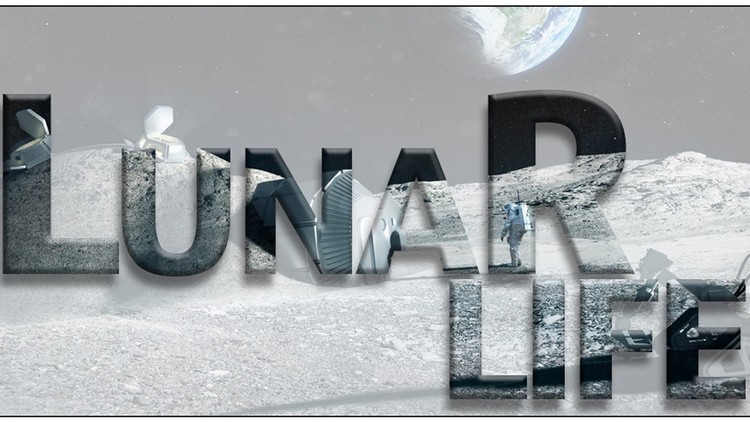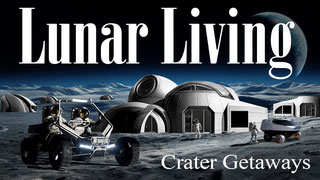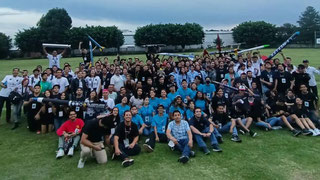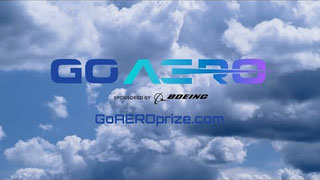Lunar Life represents humankind’s passion for breaking earth’s boundaries to explore and live on the moon.
It’s going to be hard living on the moon. It can be extremely cold, dusty, and dark. There’s nothing there to eat or drink. There’s not even air to breathe. However, there are resources that we can use. Leveraging technology will enable us to combine lunar resources with our own to sustain a human presence on the moon.
To compete in this challenge, submit an idea that will assist NASA with sustaining a human presence on the moon by helping to overcome the challenges posed by such a difficult environment, including lunar dust, extreme temperatures, lunar resource mining, resource reusability, energy harvesting and management, surface transportation, in-space manufacturing, communications, etc.
Overview
Lunar Life represents humankind’s passion for breaking earth’s boundaries to explore and live on the moon.
It’s going to be hard living on the moon. It can be extremely cold, dusty, and dark. There’s nothing there to eat or drink. There’s not even air to breathe. However, there are resources that we can use. Leveraging technology will enable us to combine lunar resources with our own to sustain a human presence on the moon.
To compete in this challenge, submit an idea that will assist NASA with sustaining a human presence on the moon by helping to overcome the challenges posed by such a difficult environment, including lunar dust, extreme temperatures, lunar resource mining, resource reusability, energy harvesting and management, surface transportation, in-space manufacturing, communications, etc.
Technology Challenge Examples
- lunar dust
- extreme temperatures
- lunar resource mining
- resource reusability
- energy harvesting and management
- surface transportation for humans and/or cargo
- in-space manufacturing
Process
- Interested teams will submit an Initial Proposal (up to three pages) describing their concept and projected results
- The top several cash prize eligible proposals will present via Video Conference with the winners being chosen from these finalists
Eligibility
- Cash prizes are limited to US Citizens only. However, there are no citizenship requirements for Honorable Mentions.
- Employees of Jacobs, NASA, and others who work on the Jacobs Space Exploration Group (JSEG) Engineering and Science Services Capability Augmentation (ESSCA) contract are not eligible to participate.
Guidelines
- Jacobs and its evaluation committee are solely responsible for the evaluation and selection of challenge winners.
- The submitted ideas shall not contain classified, International Traffic in Arms Regulations (ITAR) or Controlled Unclassified Information (CUI) data. Entrants must certify that all information used is taken from the public domain, generated by the team, or that the team has rights to any data utilized to prepare the proposal.
- Entrants agree that Jacobs shall have the right to publicize the award, including photographs, video, and brief summaries of the idea.
Prizes
This challenge will award three cash prizes as shown below which will be paid to the designated captain of the winning teams; distribution among the team participants is the responsibility of the team captain. Taxes will not be withheld; any tax obligation will be the responsibility of the winning team members.
- First Place: $5,000
- Second Place: $3,000
- Third Place: $2,000
Additional entries may be acknowledged in a non-cash Honorable Mention category. US Citizenship is not required for Honorable Mentions.
All team members for cash prize and Honorable Mention awards will receive a free Lunar Life t-shirt if a US Mailing address can be provided.
Timeline
- Open to submissions: August 16, 2022
- Initial proposal submission deadline: October 17, 2022 at 12 p.m. (CDT)
- Finalists notified: October 21, 2022
- Video Conferences with finalists: November 7-10, 2022
- Winners Announced: November 18, 2022
Judging Criteria
- Innovative (30%) - Does the idea present a unique or innovative approach to solving a problem? The proposal should succinctly describe the uniqueness and benefits of the proposed idea relative to the current state-of-art or alternate approaches.
- Impact (20%) - Is there a likelihood of making a significant contribution toward a critical aspect of human spaceflight? The proposal should provide a description of the impact of the proposed development on NASA missions or objectives.
- Feasibility (25%) - Is there a credible plan/path for implementation into the spaceflight program?
- Technical Approach (25%) - Does the idea demonstrate a high level of technical merit and is it grounded in sound scientific or engineering principles?
The Initial Proposal
The initial proposal (up to three pages) should include the following sections in the PDF document submitted:
- Executive Summary
- The problem your innovation aims to solve and how it will significantly enhance at least one critical aspect of human spaceflight (safety, affordability, schedule, capability).
- Your innovation, it's underlying principles of operation, and how it can be integrated into existing systems to significantly enhance human spaceflight. Include supporting data.
- Next steps to advance your innovation.
- Current level of technical readiness (TRL) and supporting explanation (https://www.nasa.gov/pdf/458490main_TRL_Definitions.pdf)
Additional information:
- Team member bios and resumes may be included and should be limited to 1 page per person. They do not count toward the 3 page limit.
- References should be in an appendix. They do not count toward the 3 page limit.
- Documents should be submitted in PDF format.
- Minimum font size is 12 pt.
The Video Conference
- 10 minute presentation
- 10 minute question and answer session
- Submit the slide package for the presentation in either PowerPoint or PDF format






